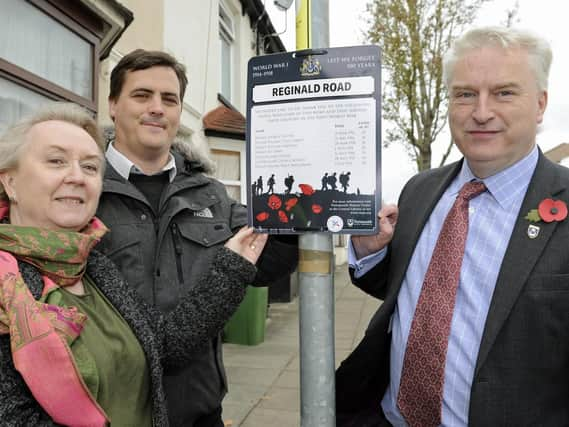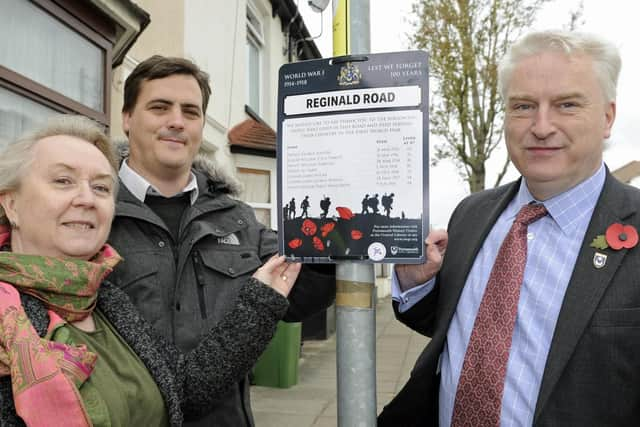Hundreds of Portsmouth streets get memorials to honour First World War heroes


But now the names of almost 6,000 men from Portsmouth who sacrificed themselves during the First World War are being honoured - in the streets where they once lived.
Hundreds of plaques with the names of the sailors and soldiers killed in the war will be rolling out across 846 roads across Portsmouth next week.
Advertisement
Hide AdAdvertisement
Hide AdIt is believed the £9,000 project, funded by Portsmouth City Council, is the first of its kind in the country and comes ahead of the centenary of the end of the First World War on November 11.


Council chief Gerald Vernon-Jackson said the authority was committed to fixing all the plaques before Remembrance Sunday.
He said: '˜The devastation families in Portsmouth would have felt during the war is hard to comprehend, it must have been terrible.
'˜That's why it's really important to remember all those who sacrificed themselves to protect our freedom.
Advertisement
Hide AdAdvertisement
Hide AdThe first of the signs were fitted today in Reginald Road. The Eastney street suffered the second-highest casualty rate of the war, with 23 men losing their lives during the course of the four-year conflict.
In the space of just a single day, on May 31 1916, four families in the street were dealt the crushing news their loved ones had been killed in the Battle of Jutland - the deadliest naval engagement of the war.
While one house, number 140, was marred by tragedy twice in the space of six months, with two men killed in 1916.
The first was Sergeant Joseph Frederick Sweetenham, who was killed on June 6, 1916. Then, on Christmas Eve of that year, Gunner R Newport was killed.
Advertisement
Hide AdAdvertisement
Hide AdHowever, the worst street affected by the war was Newcome Road, in Kingston, with 24 people killed, while 23 died in King Street.
All the names, addresses and dates of death were compiled by James Daly, a researcher at the D-Day Story, in Southsea, over 18 months.
He said: '˜It must have been horrific for the whole city of Portsmouth.
'˜Particularly the Battle of Jutland where four men in Reginald Road were killed in one day. But across the city more than 1,000 people were killed during the Battle of Jutland - possibly more.
Advertisement
Hide AdAdvertisement
Hide Ad'˜That's a thousand telegrams that were being delivered to naval families in Portsmouth.'
He added the project was about giving people a greater understanding of who those killed were.
'˜We can look down the names and see here in Reginald Road that quite a few of these guys were Royal Marines; the Royal Marines barracks is half a mile away. So we're starting to give people an idea of what life was like in their street during the war,' he said.
Mum-of-three Cherelene Noronha, 36, lives in the former home of Gunner James Nolan who died on October 16, 1918 - less than a month before the war ended.
Advertisement
Hide AdAdvertisement
Hide AdShe said: '˜This is a really good idea. We have to remember these people who sacrificed themselves.I can't imagine what it must have been like at the time to see so many people dying in the street.'
Husband and wife Dennis and Sheila Spurgeon, of Drayton, were among the first to see the new plaques.
Sheila, 78, said: '˜This is a wonderful idea. I know there is everything going on in Guildhall Square but this really brings it home to people about how many people in a street died.'
Streets where people died but that now no longer exist will have plaques placed in areas closest to where they would have been.
Advertisement
Hide AdAdvertisement
Hide AdAny residents with information about the fallen from the First World War are being urged to contact the Portsmouth History Centre, on 023 92 68 8046 or [email protected]
Have you read?
Â